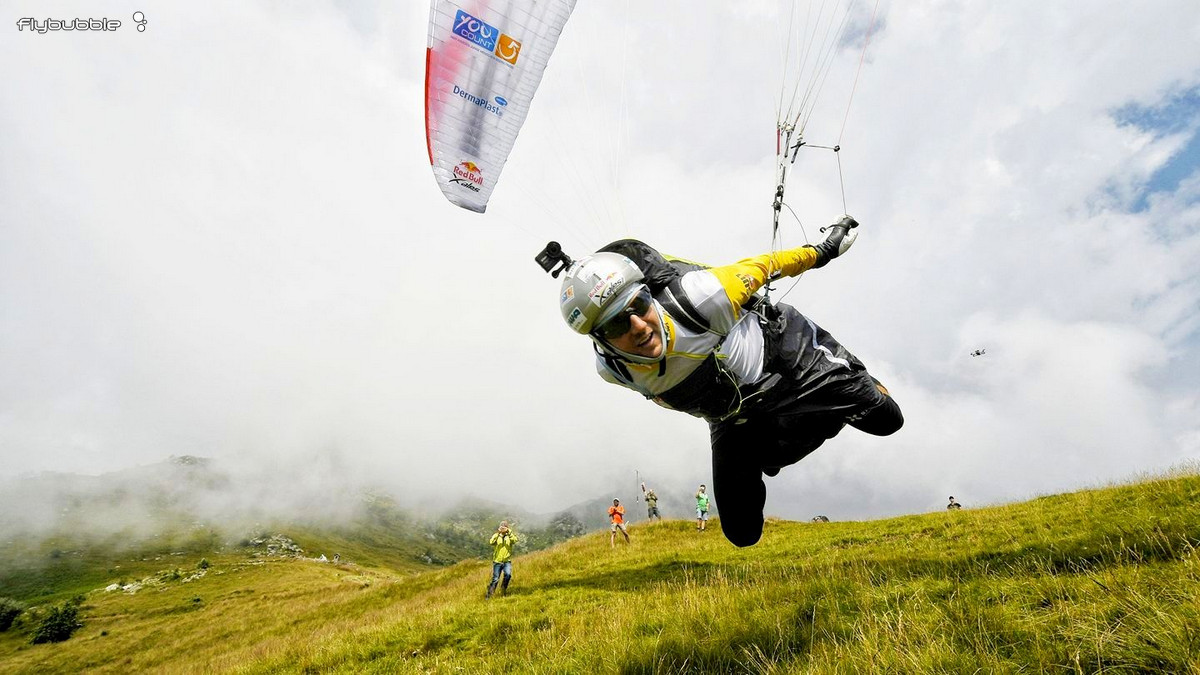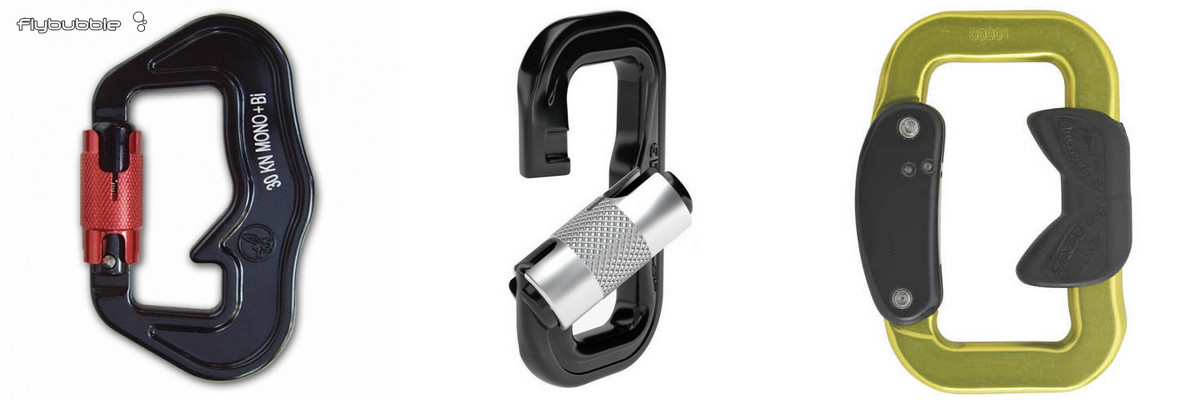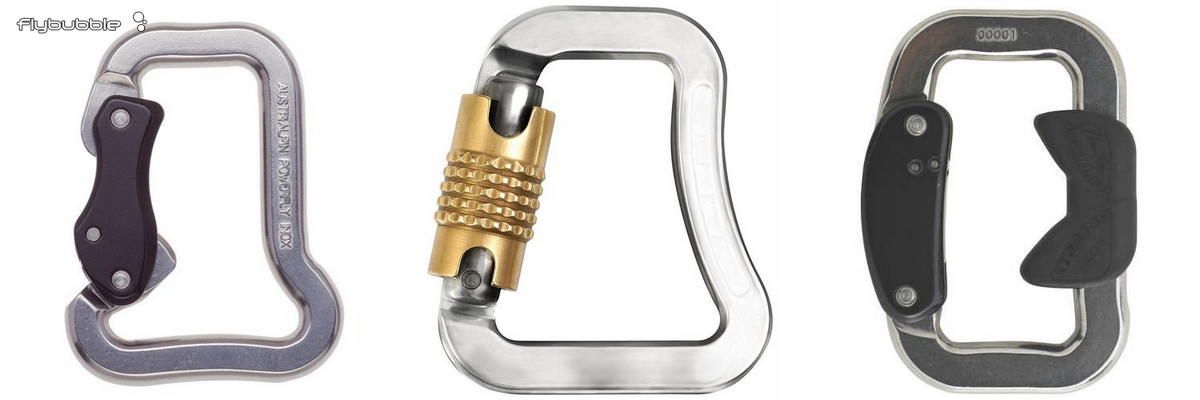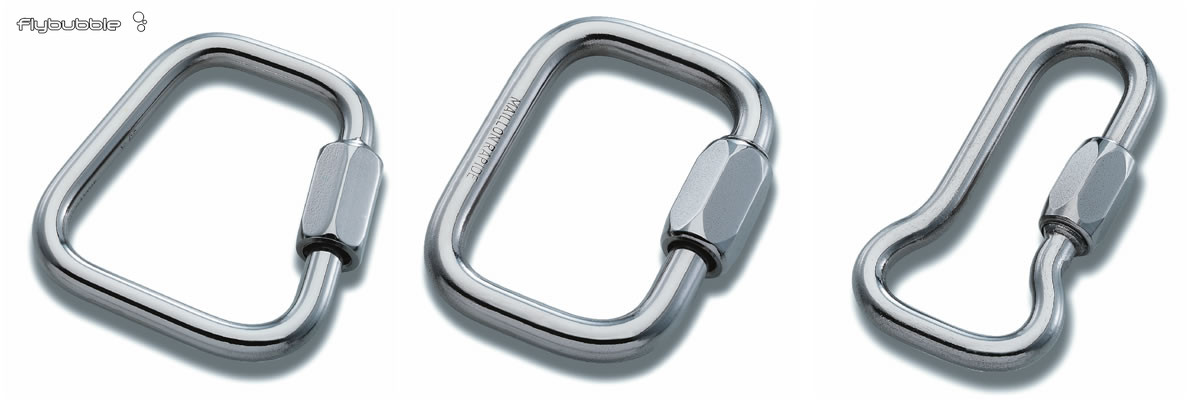
Connectors in this category come with a specific set of uses, which must be adhered to. For example, don't use karabiners designed for solo paraglider use for tandem paraglider use, like connecting the tandem wing risers to the spreaders1.
NB - This series of articles is designed to help you make an informed choice on the connectors you use. It's not an exhaustive analysis, and so the more esoteric aspects of wear, damage mechanisms and metal fatigue2 have therefore been left out.
Karabiners
Karabiners are a metal connector with an opening on one side, called the gate. The openings are usually twist or click lock, which close positively and prevent the karabiner from coming open without the required action to do so. Some karabiners have a feature to ensure the risers and the harness connection point remain correctly oriented in the karabiner, as there is a requirement for the karabiner to be correctly loaded. In addition to this, some manufacturers are offering different widths at the top and the bottom of the karabiner to allow closer matching to the width of both the harness and riser webbing. This may influence your choice of connector.
This is the full selection of karabiners

Aluminium karabiners
Aluminium3 karabiners are the mainstream choice for attaching solo wings to harnesses, as they are light, easy to use in connection and disconnection, and last for a reasonable length of time. They need to be handled with care to avoid knocks or being dropped on hard surfaces. In the absence of guidance from the manufacturer, it is recommended that they be replaced within 2 years or 200 flight hours, whichever is soonest.
In the last 25 years there have been a number of incidents with breakages reported, but where there has been the opportunity to subject the failed items to forensic examination and gather facts on time in use, the karabiners have been found to be either well outside their service life or have been subject to damage which has led to the propagation of a crack, ending in subsequent failure.
The wide choice in aluminium karabiners allows their dimensions to be matched closely to widths of webbing on harnesses, and harness manufacturers like Advance now offer detailed guides as to which karabiners are suitable for which harnesses.
Aluminium karabiners are often sold as being made of the trade name for the particular alloy, like Zicral.

Stainless steel karabiners
Stainless steel4 karabiners will have a higher maximum load for the same size but will weigh much more for that size. They tend to have a longer life, and are often the choice of hang glider pilots for their one attachment to the glider. With the higher maximum load on these connectors, the safety factor can be more than 10. The two in the online shop have ultimate load limits of over 25kN, which is more than a safety factor of 10 on a 250 kg load.
For paragliders, they are often recommended for the main tandem wing to spreader connection. They are heavier and still have a recommended life, and therefore there is no better choice vs aluminium, just a more appropriate choice for a particular use. A significant number of aluminium karabiners are not suitable for tandem wing to spreader connection.
Hang glider pilots have moved from using two aluminium karabiners to using one higher load rated stainless steel karabiner, the problem with having two connectors in close proximity was that they could scratch each other or knock together, reducing their life and eroding the redundancy originally offered. The move to one single stainless steel karabiner started in the last century.
As the following video from Supair shows, it's vital for the gate to be closed, as this achieves the full structural integrity of the karabiner.
Tensile test Supair stainless steel self locking carabiner to see the differences between an opened and a closed carabiner.
Maillons (aka quick links)
Maillons are metal connectors secured by a threaded sleeve across the gate. The sleeve across the gate needs to be firmly done up, to avoid it coming loose. This can be done by hand, or with a small spanner, but for this reason those who connect and disconnect the wing on every flight should consider karabiners for ease of use and avoiding the problem of it coming undone or being done up too tight to get undone when required.

They are often used when there is a permanent connection to be made, which can then be nipped up tight with a small spanner, such as for a reserve.
There is a choice of materials and sizes for maillons and it's important to check their purpose matches yours before buying. We strongly recommend you only use the highest quality maillons, WLL engraved and approved for freeflight.

Consider them for wings where the harness is very rarely disconnected. Checking the sleeve is fully done up across the gate is part of the checks before each and every flight. It is this lack of automatic closure which has led to karabiners being a preference over maillons. This is not a get out for checking that any gate on a karabiner is closed - it's still vital to do so, as karabiner failures due to open gates, whilst very rare, are not unknown.
This is the full selection of maillons
Karabiners are often preferred to screwgate maillons as they close positively and cannot “come undone” as well as being very easy to change gliders or harnesses with. However, other connectors do not just “come undone” they open up after a while when they have not been checked for proper closure. A karabiner must still be checked for positive closure before every flight.

Soft links
Soft links are mostly used for the weight reduction they offer. The Gin “Soft Shackle”, for example, is 8g in weight, as against 51g for a typical aluminium karabiner, or 118g for stainless steel. In spite of this low weight, it has a very high breaking strain, so strength is not compromised. Soft link use is more involved than with a straightforward karabiner, so they are targeted at the hike and fly market, and experienced pilots who understand the nature of the fastening methods used. They are made of materials like Dyneema, and despite this can be used for webbing to webbing connections. Where webbing to webbing contact occurs, this area needs to be added to the daily inspection to monitor the wear and tear and ultimately the breaking of the individual fibres in the webbing. Soft links also need to be checked for changes in dimensions, as they can change in use.
The following video shows a Gin Soft Shackle soft link being used as a connector:
See current Soft Links listed on our website.
Soft links have their own care regime which is very different from the ones specified for metal connectors. Please read the manual and stick to the manufacturer's instructions. You will need to learn new fastening methods, which must be correctly adhered to as this is the fastening between your harness and your wing, and any failure will be catastrophic.
Related reading
Choose The Right Connectors series:
Choose The Right Connectors — Flybubble
Connecting the reserve parachute — Flybubble
Connecting the speed system — Flybubble
Choose The Right Equipment series:
Choose The Right Paraglider — Flybubble
Choose The Right Paragliding Harness — Flybubble
Choose The Right Reserve Parachute — Flybubble
Choose The Right Flight Instrument — Flybubble
1 - Spreader - the attachment to a tandem glider which then splits downwards into the two attachments for the pilot and passenger. A.k.a. "tandem spreaders".
2 - Metal fatigue - this is a phenomenon where a piece of metal has a load applied to it in repeated cycles, the load is nowhere near the limit load, but despite this it fails after a very large number of these cycles, catastrophically.
3 - When we say aluminium, we are referring to aluminium and alloys of the same. An alloy is when a metal has small amounts of other metals mixed into it when it is molten, to improve certain characteristics, e.g. to make it stronger or more resistant to corrosion.
Titanal is a metal alloy composed of about 85% aluminium and the rest is zinc, magnesium, copper and zirconium. It's produced by Austria Metall AG or AMAG, the biggest company in the Austrian aluminium industry sector. Commonly used in high performance sports products, particularly snowboards and skis.
4 - Stainless steel - referred to as INOX ("acier inoxydable") in French - is an alloy of iron and mostly chromium, but can involve nickel and molybdenum. The main property of stainless steel is that it does not rust, and therefore requires no surface coating or frequent cleaning to maintain its condition.
Brought to you by Flybubble
Like what we do? The best way to support us is to buy gear from us and recommend us to others, thank you!
